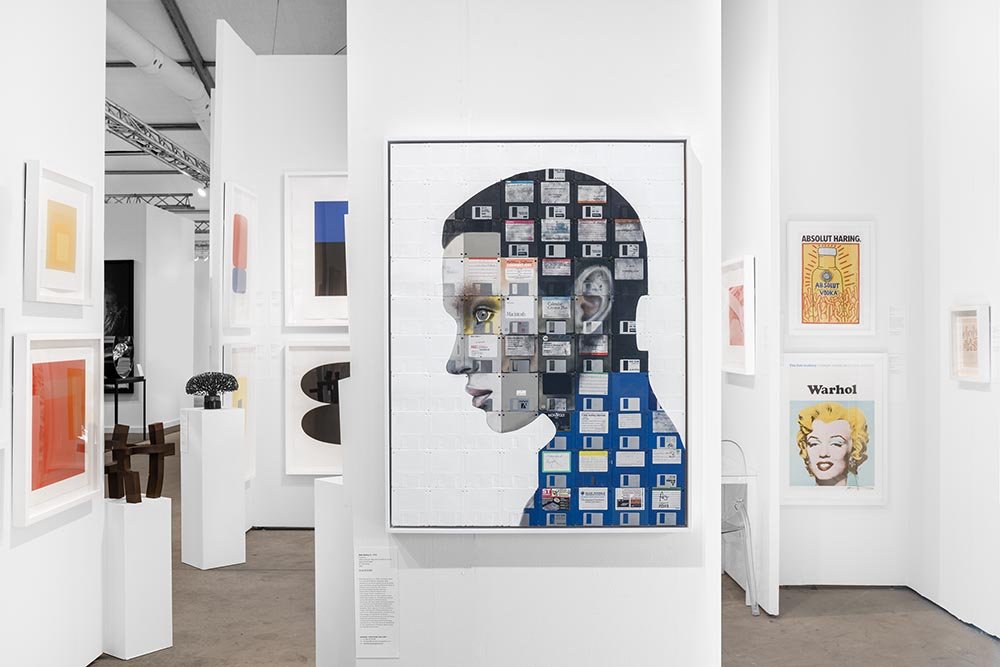ID Merge
Solo show
Opera Gallery, Paris
2019
Interview with Fleur Baudon for Arts in the City
Nick Gentry sculpts the faces of time on computer disks. The portraits of questioning.
Can a human being become obsolete? Can portraiture be reinvented? Does painting have a future? Are we still really human?
So many almost philosophical questions raised by Nick Gentry, a great name in contemporary art of barely 40 years old, currently exhibited in one of the most prestigious Parisian galleries, at the Opera Gallery.
Portraiture re-invented
We therefore enter here into what could resemble a superb museum of fine art, and we go upstairs by the grand staircase, impressive moreover, to enter this gallery of portraits of a new genre.
Recycled hybrids
At first glance, a collection of female faces, the embodiment of idealised beauty, fine lines, perfect contours, flawless ... or almost. Because these faces are as beautiful as impassive, without emotion, without age, smooth.
Our society has erased the traces of time, marks and other wrinkles, in search of absolute and universal perfection. Our artist does the same.
Floppy disks
Finally, at first glance. We approach and these paintings are metamorphosed. Exit painting, it is the material that jumps out at us, the artist sculpts the image using not marble or bronze but floppy disks and vinyls…
A playful and original field of creation for his hybrid paintings, but not only. With his works, our artist offers a new life to these forgotten objects.
Archaeological portraits
His spectral images seem to have come from a future that is no longer there… And that's where we really understand his work. Because there is no question of portraits, or even of materials. Nick Gentry paints time, our time. Modern Mona Lisa.
What matters is neither the gaze that follows you, nor the outline of a potential smile on these faces, it is all the unspoken, or rather the invisible, the mystery, the unknown.
Human or something else?
Leonardo da Vinci did not deliver his works with a manual ... A doubt invades us elsewhere. Are we sure it is the face of women? Are they really human? Do they belong to the past of the objects that shape them or to our future? Nick Gentry will not wait to have the answers before asking us questions.
Archaeological art
His works encapsulate the timeline in an almost archaeological approach, superimposing the layers of memories, accumulating the tools for storing our data. These personal data elevated today to the rank of icons, a little like these untouchable contemporary Madonnas who fix us with their metallic eyes.
Fragmented artworks
Because unlike a traditional painting, these portraits have a soul. They encapsulate in the very material of their design the memories of thousands of people, this music that we listened to 100 times, this air of jazz which reminds us of the concert where we met, this macintosh software (neither apple nor mac) or this video game which proudly stood on a 1.47 MB diskette, less than an mp3 today…
Pixelated stories
All these portraits contain a story. So many fragments of memory, accumulated sections of life, assembled like mosaics - or rather pixels for their digital side. In a world where dematerialisation takes precedence but which stores and records everything, his portraits are truly meaningful.
The real world
They invite us to leave our Instagram screen for a moment to take the first step, in the literal sense of the term. Approach, see the works for real, in large. Putting art back in a living space, a museum or a gallery, neither digital nor miniature.
Slow down, and maybe if you feel capable, stop for a moment.
Gauguin painted "Where do we come from?" Who are we? Where are we going?" This could be the title of this disturbing series of Nick Gentry, over a century later.
“In a world where dematerialisation takes precedence but which stores and records everything, his portraits are truly meaningful.”
Nick Gentry Interview Opera Gallery Paris November 2019
The artist who paints the faces of time on computer diskettes. Opera Gallery Paris













